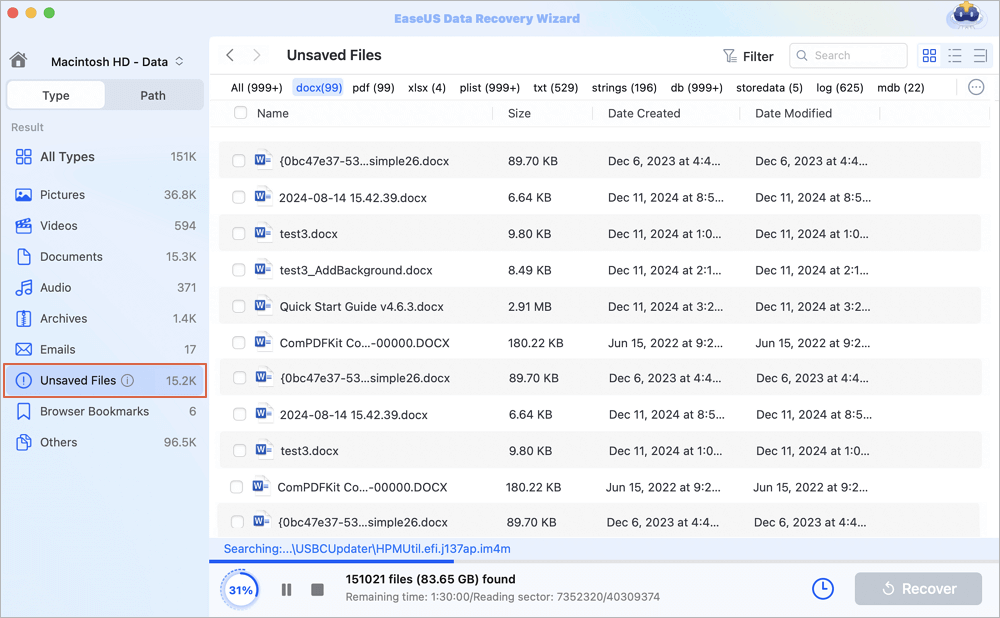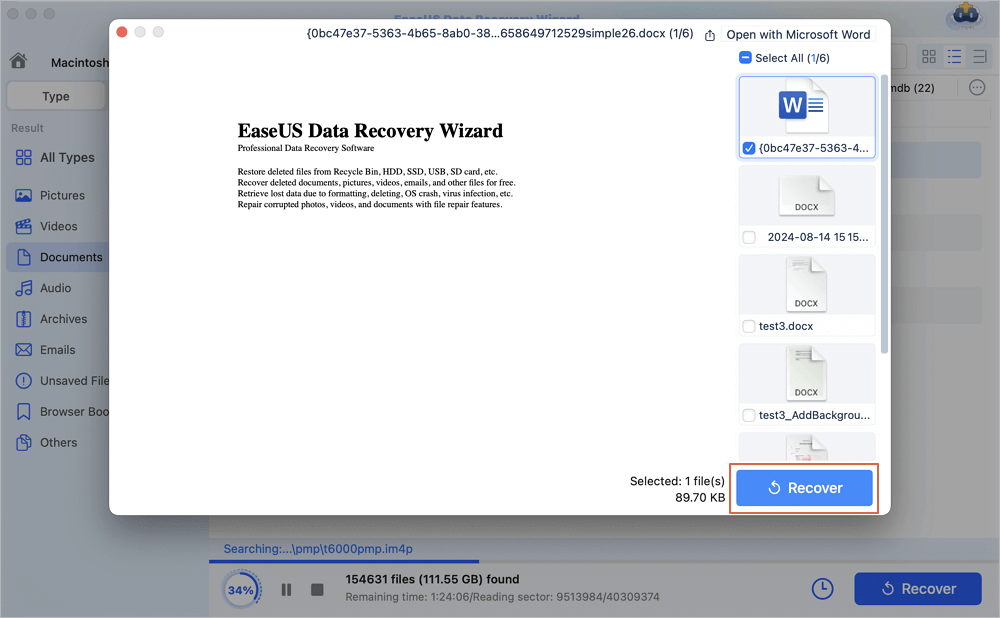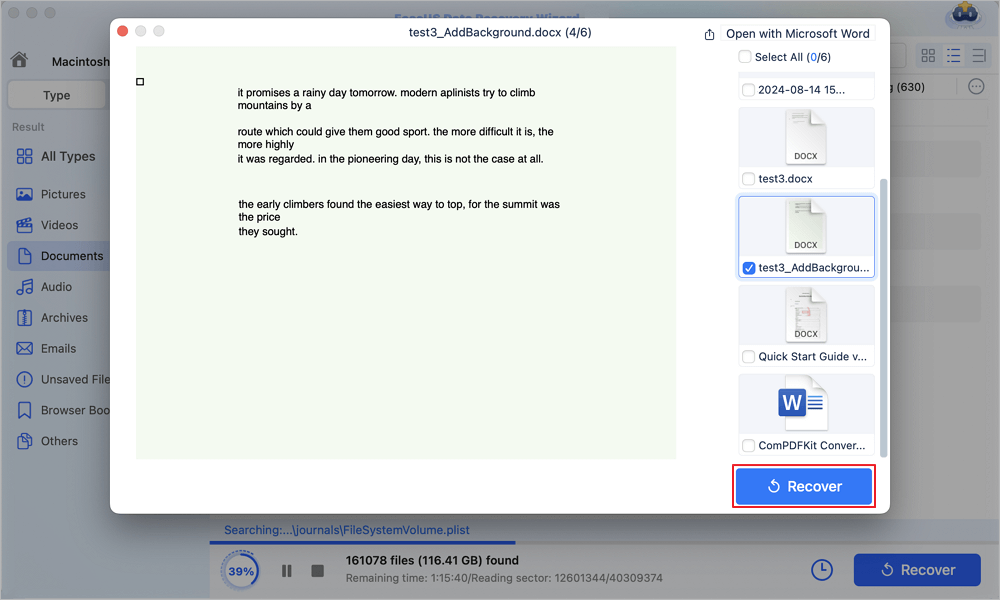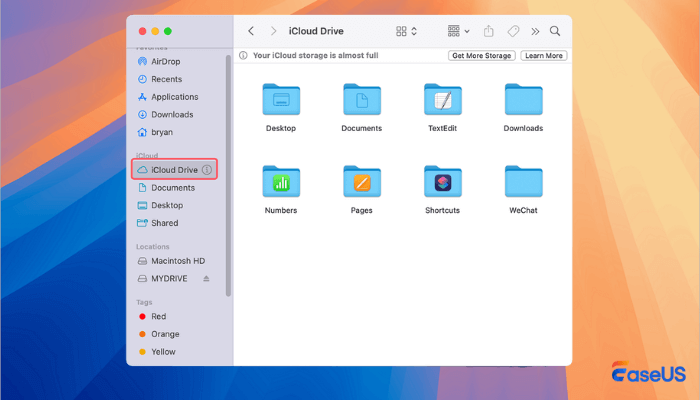Recover Unsaved Excel File Windows 10
Featured Articles
On the whole, Excel files may get lost due to a program crash, Mac shutting down unexpectedly, accidental deletion, hard drive formatting, or a virus attack. How to recover unsaved Excel file on Mac? You can first check the AutoRecover folder and the temporary folder. You can also restore your files from a Time Machine backup or use a data recovery tool as your assistant.
| ❓Core Issue | 💅Solution | Description | ✌️Rate |
| Recovering Unsaved Excel Files (App crash, closed without saving) | Professional Data Recovery Software | Scans the disk at a low level to find residual temporary files and reconstruct them | ⭐⭐⭐⭐ |
| Recover from AutoRecovery Folder | Search for Excel's autosaved backup files in a specific path (~/Library/Containers/.../AutoRecovery). | ⭐⭐⭐ | |
| Recover from Temporary Folder | Use Terminal to open the temp folder ($TMPDIR), look for temp files in TemporaryItems. | ⭐⭐ | |
| Retrieve from Open Recent | Locate and find your files you have once opened from the Recent Files. | ⭐⭐⭐ | |
| Restore from Time Machine Backup | Enter Time Machine, browse backup snapshots, restore the folder containing temp files or saved files. | ⭐⭐⭐⭐ |
This post offers 6 reliable methods to help you recover unsaved Excel files on Mac and 3 ways to help you recover deleted/lost Excel files on Mac. If you happen to lose an unsaved Excel file or delete it by mistake on a Mac, stay calm and pick up any method to bring your lost Excel file back now.
Fix 1. Recover Excel File Mac with Professional Data Recovery Software
⭐Knowledge Center: Why can a data recovery tool restore unsaved files on Mac?
When you delete a file, your Mac doesn't erase it. Think of it like this—your Mac removes the file's "address" from its internal index and marks that space on the drive as available. But the original data? It stays put. It remains fully intact, right where it was, until new files come along and overwrite it.
EaseUS Data Recovery Wizard for Mac provides a specialized, effective, and safe method for macOS users to recover unsaved Excel files. Its ability to locate hidden temporary data, coupled with powerful reconstruction algorithms and a user-friendly preview system, makes it an excellent tool for rescuing invaluable, unsaved work from being permanently lost.
Other than unsaved Excel files, this Microsoft data recovery tool can also restore unsaved Word documents on Mac and fix errors like cannot save Excel files on Mac.
Review:
- The program works well. I was able to recover 90% of my checkbook register that used Excel 2007 when my internal HDD started to fail on my old computer, as well as fix some indexing problems on some old movies I had. Support worked with me to transfer the program key to my replacement computer without a problem. from Trustpilot
- I accidentally reformatted my external hard drive and tried Disk Drill which I was able to recover 80% of my data and all disorganized. A day after that while browsing internet I saw the EaseUS and decided to try and was able to recover 100% of my files and organized before I had the accident. I'm very happy and I wish I could give them 10 stars. from Trustpilot
- I also appreciated the flexibility of Data Recovery Wizard, as it was able to recover files from a variety of storage devices including my hard drive, USB drive, and SD card. from Trustpilot
Download the software and follow the 3-step guide below to get your lost Excel files back on Mac:
Step 1. Select the disk
Launch EaseUS Data Recovery Wizard for Mac, hover the mouse over the device where you lost an unsaved file, and click "Search for lost files".

Step 2. Choose unsaved documents
After the scan, click "Type", and expand "Unsaved Documents". Click the exact file type - Word, Excel, Powerpoint, Keynote, Pages, or Numbers you lost without saving.

Step 3. Preview and recover unsaved files
Double-click to preview your unsaved file, select the right version and click "Recover" to save the file to another secure location on Mac.

Hope this video guide can make it easy for you to follow suit and recover Excel file not saved on Mac:
- 00:16 What causes Excel files not saved on your Mac
- 00:38 Method 1. Recover TMP Folder
- 01:06 Method 2. Recover from AutoSave
- 02:05 Method 3. Use Recovery Software

Remember to sahre this tool with users who are facing the same unsaved Excel file error and help them retrieve their precious data:
Method 2. Recover Unsaved Excel File Mac from AutoRecovery
The AutoRecover feature in Microsoft Excel acts as a vital safety net, designed specifically to prevent data loss from unexpected events like application crashes, power outages, or accidentally closing without saving. Its ability to recover unsaved work is based on a simple but effective automated process. So do as follows to get your files with AutoRecovery:
Step 1. Launch Finder on your Mac.
Step 2. Choose "Go" from the drop-down menu and then go to the Folder.
Step 3. Type the following command and hit Enter:

Step 4. Next, open the AutoRecovery folder and locate the file starting with "AutoRecovery save of." Then, select the item you wish to restore.

Method 3. Recover Unsaved Excel Files Mac from the Temporary Folder
The ability to recover an unsaved Excel file from the Temporary folder is a direct result of a built-in safety feature in Microsoft Office for Mac and Windows. This process works not by magic, but by leveraging how the software automatically manages your data. Follow the steps below to restore the unsaved Excel files on Mac from the Temporary/Temp folder.
Step 1. Go to "Applications" > "Utilities" > "Terminal".

Step 2. Type open $TMPDIR and press "Return" to open the Temporary files folder. Select the folder named "TemporaryItems".

Step 3. Find the unsaved Excel file under "TemporaryItems" and restore it.
Method 4. Recover Unsaved Excel file Mac from Open Recent
In Excel, the "Open Recent" option shows files you worked on lately. But if you never saved the file, you probably won't find it here. That list mostly only includes files already saved on your computer. Here is how you can locate and find your unsaved Excel files from the Recent Files:
Step 1. Open Excel on your Mac.
Step 2. Click File at the top and choose "Open Recent".
Step 3. Look through the list for your file and open it once you find.
Method 5. Restore Unsaved Excel file from Time Machine
When you're working in Excel, even if you never hit Save, the program automatically creates temporary backup copies of your workbook in the background. These are stored in a hidden system folder called AutoRecover. You usually can't see these files, and if you close Excel without saving, they usually get deleted. But here's where Time Machine comes in.
Time Machine works by taking regular snapshots of your entire hard drive – including all those hidden system folders and temporary files. So even if the temporary AutoRecover file has been deleted from your Mac, a previous version of it is likely still sitting in a Time Machine backup from before you closed the document. Here is how you can do this:
Step 1. Locate and click the Time Machine icon and choose "Browse Time Machine Backups".

Step 2. Now, you can use the arrow to adjust the time to the point where your files are still there.
Step 3. Choose the file you want to recover and click "Restore" to get it back.

Extra Tips: How to Recover Deleted Excel Files on Mac
1️⃣Restore Deleted Excel Documents with Data Recovery Tool
You can retrieve the unsaved Excel file using either of the two approaches mentioned above. But you can't use them to recover lost Excel files due to accidental deletion, hard drive formatting, system crash, or storage device corruption. Then, what to do in this kind of circumstance? Don't worry. Here comes EaseUS Mac File Recovery Freeware. As a leading data recovery tool, it allows you to fix Excel won't open on Mac and perform Office document recovery, email recovery, photos recovery, and other data recovery.
Install it and follow the following tips to restore deleted or lost Excel files on Mac in 3 simple steps.
Step 1. Scan for lost documents
Select the location where your important Word/Excel/PPT/Numbers/Pages documents were lost and click "Search for lost files".

Step 2. Find lost documents on Mac
EaseUS Data Recovery Wizard for Mac will immediately start a scan on your selected disk volume. Meanwhile, the scanning results will be presented in the left pane. Select "Documents" and you can quickly filter the DOC/PDF/PPT/XLS files you've lost earlier.

Step 3. Recover lost/deleted documents
Select the target files and preview them by double-clicking them. Then, click "Recover" to get lost documents back at once.

After this, you'll get the lost Excel file back and continue your job with the file again. You can also apply this Mac data recovery software to restore deleted photos, music, videos, or other data on Mac for free.
2️⃣Recover Deleted Excel Files from Trash
Recovering a file you've accidentally deleted is straightforward if it's still in the Trash. Here's how to do it:
Step 1. Click the Trash bin icon from the dock and then open the Mac Trash folder.
Step 2. Look for the deleted files you want to recover and click them. Choose "Put Back" to restore them to the original location.

3️⃣Recover Deleted Excel Files from iCloud
If you regularly back up your files using online storage services like iCloud, OneDrive, or SharePoint, you can also easily restore deleted Excel files. Here we will take iCloud as an example:
Step 1. Visit the iCloud website and log in to your account.
Step 2. Go to iCloud Drive and select Browse.
Step 3. Find the Excel file you want to recover and click "Download a Copy".
Or, you can directly go to the iCloud Dirve to better locate your missing files.

The Bottom Line
This post provides you with three ways to recover unsaved Excel on macOS Ventura, Monterey, Big Sur, and more. I hope these solutions work for you. Besides, EaseUS data recovery software for Mac works well in recovering data from a hard drive, SD card, SSD, and other devices. Try this tool to recover deleted files on Mac.
Recover Unsaved Excel Files on Mac FAQs
Read the questions and answers below to get better help recovering unsaved Excel files on Mac.
1. Where are Excel autosave files stored on Mac?
There is an AutoRecovery folder for Microsoft users. When you forget to save files or delete Excel files, you can find the Excel files this way:
defaults write com.apple.Finder AppleShowAllFiles true
2. How to recover deleted Excel files on Mac?
The easiest way to recover deleted Excel files on Mac is using free data recovery software for Mac:
- Download and run EaseUS Mac data recovery software
- Open the software and select the drive and click Search for lost files
- After the scan, select the Excel files
- Preview the Excel files and recover the data
3. How do you recover unsaved Excel files after clicking don't save on a Mac?
Three ways to recover unsaved Excel files:
- Run Excel data recovery software
- Check the autosave folder
- Check your backup folder
4. How to recover overwritten Excel files?
Follow these steps to recover overwritten Excel files:
- Open Excel, and click File > Info > Manage Workbook.
- Click Recover Unsaved Workbooks from the drop-down menu.
- Select the unsaved file and click the Open button.
- Then, choose Save As at the top of the file bar to recover it.
Was This Page Helpful?
Finley is interested in reading and writing articles about technical knowledge. Her articles mainly focus on file repair and data recovery.
Written by Tracy King
Tracy became a member of the EaseUS content team in 2013. Being a technical writer for over 10 years, she is enthusiastic about sharing tips to assist readers in resolving complex issues in disk management, file transfer, PC & Mac performance optimization, etc., like an expert.
Related Articles
-
How to Remove Application Leftover Files Mac | Clean Up Leftover Files
![author icon]() Dany/Aug 18, 2025
Dany/Aug 18, 2025 -
macOS Update VS. Clean Install: How to Choose
![author icon]() Jean/Aug 18, 2025
Jean/Aug 18, 2025 -
How to Delete a File on a Mac [Four Plans Provided]
![author icon]() Dany/Aug 18, 2025
Dany/Aug 18, 2025 -
How to Fix Failed to Create macOS Installer OpenCore on Mac
![author icon]() Dany/Aug 18, 2025
Dany/Aug 18, 2025
